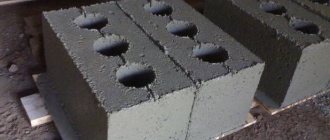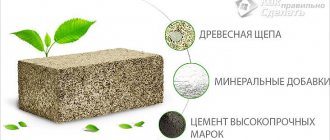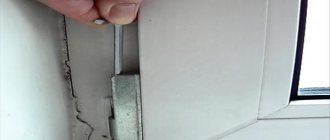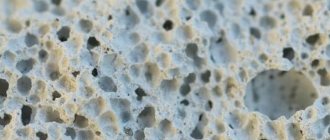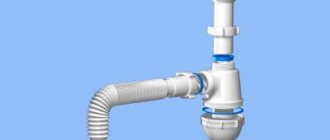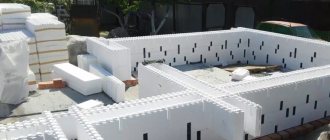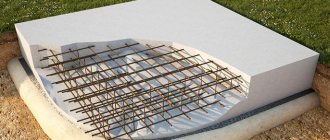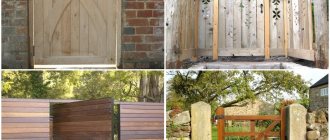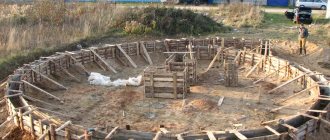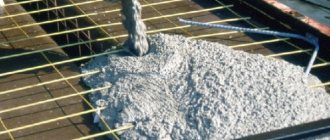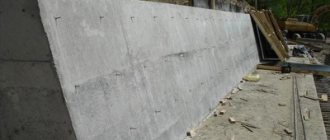What is aerated concrete
Aerated concrete building blocks can come in different sizes and shapes. But their composition is almost always the same. You can make aerated concrete blocks with your own hands from:
- high quality cement; lime; quartz sand; gypsum; aluminum powder; water.
The production technology of this material is quite simple.
You can produce aerated concrete in the yard of your home or directly at the construction site. Ready-made blocks are parallelepipeds made of a porous concrete mass containing many small air pores. They measure about 3 mm.
Pores are formed by adding aluminum paste or powder to the solution. Sometimes, in addition to the listed components, some other substances are added to the composition in very small quantities. They are needed to change some parameters of the building material.
According to the production method, aerated concrete can be made using autoclave and non-autoclave methods. The first method is not suitable for home use.
It requires expensive equipment. The non-autoclave method is simpler; it allows you to set up the production of aerated concrete yourself at home. During production, a reaction of water with aluminum powder is used, as a result of which a huge amount of carbon dioxide is released, which forms pores inside the blocks.
The mass hardens after some time. This happens in natural conditions. The body of the block receives many pores from 1 to 3 mm in diameter.
Mini-plant for the production of non-autoclaved aerated concrete
The porous structure is the main advantage of the gas block.
Pores make the material light and give it high thermal insulation properties. The density for aerated concrete is kept at the level of 300-1200 kg/m³. In order for the pores to hold firmly in concrete, it must be placed in a strong form, which determines the size of the future block.
The mass hardens in 2 hours. After this, the blocks can be removed from the mold and placed on racks to completely harden. The final strength is formed only on the 28th day of natural drying of the blocks.
What does aerated concrete consist of?
Aerated concrete is an artificial stone that is used to build walls in individual construction. It is suitable for the construction of load-bearing structures, internal partitions and filling inter-frame spaces. Aerated blocks do not place a large load on the foundation because they have a cellular structure and are light in weight. This is an economical building material with high thermal insulation properties.
There are several types of classification of cellular concrete: depending on the purpose, shape, production technology and composition.
1. Based on the processing method, a distinction is made between autoclaved and non-autoclaved aerated concrete.
2. According to their purpose, gas blocks can be heat-insulating, structural or structural-thermal-insulating. They have a certain marking, for example, aerated concrete d500 belongs to the class of structural and thermal insulation blocks.
3. Based on the form factor, they are divided into U-shaped, straight and tongue-and-groove.
Aerated blocks are made from sand, cement, lime, water, gypsum and aluminum powder. Also, secondary and by-product industrial materials such as slag and ash can be used in production.
The building mixture is converted into artificially synthesized stone only under certain conditions. To obtain it, autoclave hardening technology is used. In this case, the composition hardens under the influence of saturated steam and high pressure, changing its structure. The mixture produces the mineral tobermorite, which gives the material strength. This is how autoclaved aerated concrete is obtained.
Concrete that hardens under natural conditions is called non-autoclaved. It has a cellular structure, but differs in its properties from gas blocks made using special technology. This building material is more susceptible to shrinkage during operation, so it is advisable to use it in cases of light loads. To increase the strength characteristics of non-autoclave blocks, various reinforcing substances and fillers are added to the initial composition. The use of polyamide plastics for reinforcement can reduce shrinkage deformation.
The production of non-autoclave blocks does not require expensive equipment, so you can make them yourself.
Making aerated concrete with your own hands
Producing aerated concrete at home requires some tools. You need to prepare:
- a grinder with a disk; a hacksaw for wood; an electric drill; a plane; a hacksaw for working on metal; a sharp knife; a plumber's hammer; a shovel for mortar; a mixer for mixing the mixture; a ruler; a hair dryer; a trowel, a steel string for cutting blocks; a spatula; scales ;chisel and chisel;measuring bucket.
Using a measuring bucket and scales, the necessary components for the solution are measured. The production of gas blocks is carried out from the following components:
- Portland cement grade M400-M500 - 50-70%; sifted quartz sand - from 20 to 40%; lime as a plasticizer - 1-5%; aluminum powder or paste - 0.04-0.09%; water - 0.25 -0.8%.
Collapsible metal form Pouring lightweight concrete Removing excess concrete mortar Blocks after stripping
The mixture is thoroughly mixed and laid out in forms, which come in different shapes. This can be a pretty durable box. Its height is equal to the height of the blocks.
The total volume is 4-9 gas blocks. The molds can be made of wood or metal. It is advisable to make the structure collapsible.
A more complex option is a box with cells, which can be made of wood 30-40 mm thick, or metal 4-6 mm thick. Internal partitions can be made of plywood. Its thickness should be 12-15 mm.
Before pouring the solution, the surfaces from the inside must be lubricated with technical oil and the entire structure must be heated with a hairdryer to 40˚. The mixture is poured to the level of half the height of the box. The remaining space will be filled as the composition expands and pores form.
The gas release reaction lasts 6-8 minutes. The solution first rises, then shrinks slightly. After shrinkage, you can cut off the upper part with the prepared string and remove the blocks from the mold.
Cooling of the blocks should occur under natural conditions. The use of fans is not recommended. It is recommended to install the mold on a flat horizontal surface.
It is better to prepare several boxes at once in order to mix a significant amount of solution. The work site must be sheltered from wind and precipitation. The block sizes can be chosen at your own discretion.
Features of aerated concrete
Aerated concrete blocks are regular parallelepipeds made of porous concrete.
The material itself is a type of cement-based concrete in which air pores up to 3 mm in size are evenly distributed. Aluminum powder or paste is usually used as an additive to form pores. In general, the concrete mixture has the following composition: cement, sand, aluminum powder, water, and various additives.
Technology for the production of aerated concrete blocks.
According to the manufacturing method, aerated concrete is divided into autoclave and non-autoclave. The first type of material is obtained in an autoclave at elevated pressure and temperature, which is realized only in industrial conditions that ensure proper control of the process in extreme conditions.
The non-autoclave manufacturing method is implemented under natural conditions, which allows you to use it yourself.
The production technology is based on the fact that when aluminum powder comes into contact with water, a violent reaction occurs with the release of carbon dioxide. If this process occurs in a closed form inside a viscous mass, then the gases form pores in the volume of this material. Even after the gases leave the mixture, the pores remain in the thickness of the mixture.
After the mass hardens under normal atmospheric conditions, aerated concrete is obtained, i.e. concrete with closed pores in a shape close to round, with a diameter of 1-3 mm.
The porous structure provides the main advantages of the material, namely high thermal insulation properties combined with low specific gravity with sufficiently high compressive strength. Aerated concrete blocks have a density from 300 to 1200 kg/m³, depending on the amount of pore-forming substance introduced.
Return to contents
The technology for producing non-autoclaved aerated concrete includes several mandatory stages and conditions. The pore-forming component is added to the cement-sand mixture and distributed evenly throughout the volume. The process of pore formation occurs quite actively with the expansion of volume when the powder comes into contact with water.
Production of non-autoclaved aerated concrete.
To retain the pores inside the mass, the gas evolution reaction must occur in forms that have sufficient strength. The internal cavity of the mold determines the dimensions of the resulting aerated concrete block. For the initial hardening of the mass, at least 2 hours are required.
After this, the concrete can be removed from the mold, but must remain stationary on racks until completely cured. The final strength value is achieved only after 28 days of drying the blocks. To make aerated concrete with your own hands, it is necessary to ensure that the basic conditions are met and a number of necessary works are carried out.
Return to contents
To make aerated concrete blocks with your own hands, you will need the following tools:
- grinder; hacksaw; plane; electric drill; hacksaw for metal; knife; hammer; shovel; mixer; ruler; hair dryer; trowel; spatula; steel string; chisel; chisel; scales; measuring bucket.
Return to contents
Composition of aerated concrete.
The standard mixture for aerated concrete contains cement, sand, water and lime.
Aluminum powder is used as a pore-forming substance. Slaked lime acts as a plasticizer. To improve the properties, it is recommended to use additional additives: sodium sulfate (no more than 0.5%) and caustic soda (no more than 1.5% by weight).
The basis of aerated concrete is cement. It is recommended to use Portland cement grade M400 or M500. The filler is taken in the form of quartz sand.
It should be thoroughly sifted to remove large fractions. Clay in sand can only be in the form of small traces and amount to no more than 7% of the weight of the sand. The following composition and ratio of concrete mix ingredients are recommended:
- cement - 50-70%; sand - 20-40%; lime, caustic soda, sodium sulfate - 1-5%; aluminum powder - 0.04-0.09%; water - 0.25-0.8%.
The mixture must be thoroughly mixed. By changing the cement content and pore-forming composition, it is possible to regulate the volume of pores in concrete, that is, change the density of the material.
Return to contents
Types of aerated concrete blocks.
In order to solve the question of how to make aerated concrete, it is necessary to ensure the production of a mold for pouring the concrete mixture.
Such forms can be of two types. The first type (the simplest) is a rectangular box with a height equal to the height of the block. The area of the box must contain the volume of mass from which several (4-9 pieces) aerated concrete elements can be made.
If a significant volume of production of gas blocks is planned, then it is better to make the mold from a steel strip 4-5 mm thick. The structure must be collapsible to facilitate the removal of the concrete blank. A removable cover must be provided on top.
It is advisable to provide for its fastening to the sides of the box using bolts (screws) or other clamps. A simplified version of the form can be made from wood. For the sides of the box you should use a board 30-40 mm thick.
The second type of shape is a lattice system.
In this design, the cavity of the box is divided by partitions into cells, in which one gas block is formed. This form can also be made of steel strip or wood. For internal partitions, plywood with a thickness of 12-15 mm can be used.
Return to contents
Before starting work, the inner surface of the mold must be thoroughly lubricated with machine oil to prevent the mass from sticking. It is recommended to heat the mold to a temperature of about 40º C. Aluminum powder is added to the uniformly mixed concrete solution and it is poured into the mold.
Do-it-yourself aerated concrete block production table.
It is necessary to pour to a height approximately equal to half the height of the side of the box, which takes into account the expansion of the mass during a chemical reaction with the formation of pores.
A violent reaction with the release of gas occurs within 6-8 minutes.
At this time, there is an active increase in the level of mass in the form. At the end of the reaction, the expansion of the composition stops, and then a slight shrinkage of the solution occurs. After stopping the vertical movement of the level, using a strong steel string, all irregularities (bumps, sagging) are cut off from the surface of the workpiece.
A heat-insulating material is placed on top of the calmed block blank: asbestos, foam plastic, etc. The mold is closed on top with a lid.
Natural drying of aerated concrete blocks is carried out.
Minimum drying time is 2 hours. After this, the monolith can be cut into blocks of the desired size. The recommended time before transportation to the storage site is 24 hours.
During the work, it is necessary to prevent the occurrence of drafts. Fan operation is not recommended. Cooling of the mass should be slow and uniform.
Return to contents
Before preparing the concrete mixture, it is necessary to check the quality of the cement: the integrity of the packaging, the production time, the presence of sticky lumps, etc. Only high-quality ingredients should be used.
The mold for making blocks must be placed on a horizontal, flat surface (preferably metal).
It is recommended to use several forms at the same time so that the solution can be mixed in large quantities at once. The manufacturing process itself should be carried out in a warm room. If the molding of blocks is carried out outdoors, then warm weather should be chosen, and the area should be closed from the wind.
It is recommended to keep aerated concrete blocks on the storage site until they reach full strength (28 days).
The mold must be heated evenly (over its entire volume). If several molds are used, then they all need to be provided with the same temperature conditions.
When choosing the size of forms, it is best to proceed not from standard block sizes, but from the sizes that are most suitable for your structure, so that in the future you do not have to frequently cut elements. It is possible to produce some elements of a different configuration by inserting into the form.
The technology for manufacturing non-autoclaved aerated concrete blocks is quite simple. With proper organization of work, the required number of building elements can be made with your own hands at home.
Home|Types of concrete|How to make aerated concrete with your own hands?
Date: November 29, 2016
Comments:0
At the beginning of construction work, the question arises: what material is the most durable, reliable and financially beneficial?
We offer an alternative solution - to set up the production of aerated concrete with your own hands. At the very beginning, it is important to understand what aerated concrete is, what properties such blocks have, as well as the scope of application. So, let's study the questions in order before making a choice.
What is aerated concrete and what are its characteristics
Before understanding how aerated concrete is produced at home, you should first consider what this material is. What qualities does he have and is it worth choosing him at all?
What is aerated concrete
Basic properties and qualities
Aerated concrete, in accordance with GOST, must have a number of characteristics, the indicators of which are strictly limited. Let's look at them and analyze how important and practical they are for the future structure. Let's use the table.
Physico-mechanical and technical properties of aerated concrete:
| Indicator name | Value in accordance with GOST |
| Thermal conductivity | From 0.09 to 0.38 |
| Frost resistance | From 15 to 35 cycles - for non-autoclaved aerated concrete, from 35 to 150 cycles - for autoclaved aerated concrete |
| Density | D300-D1200 |
| Strength grade | From B1.5 - for non-autoclaved aerated concrete, from 2.5 - for autoclaved |
| Vapor permeation | On average – 0.2 |
| Shrinkage | From 0.3 mm/m2 |
First, let's pay attention to the thermal conductivity indicator. According to technical documentation, it varies from 0.09 to 0.38. But, in practice, under operating conditions, its numerical value will be higher, since the above is typical for products in a dry state.
Thermal conductivity of aerated concrete and wall thickness in comparison with other wall materials
- The release humidity of aerated concrete varies between 25-30%.
- Frost resistance indicates how many freezing and thawing cycles a product can withstand. Some manufacturers claim that this indicator for aerated concrete can reach 150, and its service life can be up to 200 years.
- The density can be different, it depends on the porosity of the block and some other factors. This indicator determines the scope of application of the material; we will talk about it in more detail later.
- Vapor permeability is the ability of a material to exchange vapor. For example, if humidity is high, aerated concrete is able to absorb it, and if the air is excessively dry, it can release it. Thanks to this quality, the most favorable microclimate will be established in the room.
- Shrinkage is a rather unpleasant phenomenon. However, a figure of 0.3 mm/m2 is not that great. The appearance of shrinkage cracks is a common phenomenon.
Cracks due to shrinkage
Types of material and products made from it
Now let's look at what types of material there are, and what products can be obtained by starting the production of aerated concrete at home.
Depending on the density, aerated concrete is:
- Thermal insulation;
- Structural and thermal insulation;
- Structural.
The first option is characterized by a density of 300-400. It is lightweight and has a minimal thermal conductivity coefficient. And even the name speaks for itself: such aerated concrete is used as a heat-insulating material.
Structural and thermal insulation is the most popular type. Its density varies from 400 to 900. It is used in the construction of walls and partitions.
Structural – the most durable type. Its density is 1000-1200. However, the thermal conductivity coefficient is also high, which provides for additional insulation of the material. The products can withstand heavy loads and are used in the construction of buildings up to 12-15 meters high.
The conclusion suggests itself: the higher the density, the higher the thermal conductivity coefficient. Let's look at the table to see how these indicators change with each other.
Relationship between density and thermal conductivity of aerated concrete:
| Type of aerated concrete | Density | Dry thermal conductivity |
| Thermal insulation | D300 | 0,09 |
| D400 | 0,11-0,12 | |
| Structural and thermal insulation | D500 | 0,12-0,13 |
| D600 | 0,13-0,14 | |
| D700 | 0,15-0,18 | |
| D800 | 0,18-0,21 | |
| D900 | 0,20-0,24 | |
| Structural | D1000 | 0,23-0,29 |
| D1100 | 0,29-0,34 | |
| D1200 | 0,29-0,38 |
Graph of strength and thermal conductivity of aerated concrete
However, this is not the only classification. Depending on the curing method, aerated concrete can be autoclaved or non-autoclaved.
Autoclaved aerated concrete, or synthetic hardening aerated concrete, is distinguished by the fact that at the last stage of production, the products are processed in special machines - autoclaves under high pressure and temperature.
Non-autoclaved aerated concrete, or hydration-hardening aerated concrete, reaches technical maturity under natural conditions. Sometimes it is slightly heated to a low temperature, not exceeding 100 degrees, in order to speed up the process.
Note! Autoclave hardening blocks can only be manufactured in factory conditions.
GOST 21520-89 Wall blocks made of cellular concrete. The technical specifications provide for the division of products in accordance with their geometry.
Depending on the accuracy category, gas blocks are distinguished:
- First category of accuracy. Permissible deviations in size for such blocks should be no more than 1.5 mm, diagonally - no more than 2. Place the products on glue.
- Second category of accuracy. For such products, more significant deviations are established: up to 3 mm in size, up to 4 mm in diagonal. Chips at the corners are also allowed. Laying is done using both glue and mortar.
- Third category of accuracy. Such products are laid on a solution, which will undoubtedly lead to an increase in cold bridges. As a result, such gas blocks are usually used in the construction of outbuildings in the form of a garage or shed. Permissible deviations: up to 5 mm – in size, up to 10 mm – chips at the corners (no more than two on one product).
Aerated concrete is also divided depending on the type of binder component:
- On cement;
- On the ashes;
- On slag;
- On a mixed binder;
- On lime binder.
The type of silica component determines the presence in the composition:
- Quartz sand;
- Ash;
- Other secondary industrial products.
Strengths of buildings built from aerated concrete
Aerated concrete is not a universal material due to the presence of positive and negative sides.
Let's look at them and start, perhaps, with the pros:
- The products are quite light. This will significantly reduce the load on the base of the building.
- Aerated blocks are large in size, which will undoubtedly speed up the process of wall construction.
- Products are produced mainly using a mixture of lime, cement, water, sand and aluminum powder. They do not contain harmful and toxic substances. This indicates the environmental friendliness of the material.
- Fire resistance. Aerated concrete does not burn and does not interact with fire. Moreover, the products can be exposed to high temperatures for up to 2 hours.
- The material is easy to handle. It is easy to saw, sand and cut. There is no need to use any highly specialized equipment. A simple hacksaw or saw will do just fine.
- High frost resistance is a significant plus.
- The material has the ability to permeate vapor, which, in turn, makes it possible to establish an optimal microclimate.
- Soundproofing characteristics are also excellent. This will protect those in the room from extraneous noise from outside.
- The ratio of strength and thermal conductivity indicators is optimal. In this regard, aerated concrete occupies a high position among materials intended for the construction of walls.
- Variability of interior and exterior decoration. You can clad a building with almost any materials, the main thing is to follow the technology.
- A large selection of manufacturers and sizes can also be considered a plus.
As you can see, the above characteristics are quite sufficient for the construction of a practical structure with high performance indicators.
Advantages of aerated concrete
Disadvantages of products and options for eliminating them
The main disadvantage of aerated concrete is its hygroscopicity. The fact is that the material has an open pore structure, which further enhances the level of moisture absorption. Its numerical indicator reaches 25%.
During the period when negative temperatures prevail in the cold season, accumulated moisture can crystallize and begin to destroy products from the inside.
This problem can be solved. You can protect products from the harmful effects of moisture using finishing. Moreover, the cladding of the facade and the finishing of the building from the inside must be technically combined with each other in order to prevent moisture from entering the wall surface.
The options may be as follows:
- If the facade is made without the use of ventilation, then the interior decoration must be airtight. For example, brick cladding can be combined with tiling inside.
- When installing a ventilated facade, the presence of a sealed finish is not necessary, since condensation will escape.
Options for external finishing of aerated concrete walls
More minor disadvantages of aerated concrete are:
- The need to purchase special fasteners for fixing elements, and, if you want to fasten particularly heavy objects, you need to plan the nodes and strengthen them. This applies, for example, to radiators or other products that have a high level of breakout.
- Fragility of products. This is especially noticeable during transportation and work. A certain number of blocks may appear with chips and cracks.
- Shrinkage. This is typical for gas blocks. It is not uncommon for cracks to appear on finished walls.
And these disadvantages can also be partially offset. For example, so that cracks do not spoil the appearance of the building, and there is an opportunity to correct them, you should not rush with finishing. Give the structure a chance to settle a little.
At the same time, it is worth observing the seasonality of the work. Since leaving aerated concrete walls unprotected for a long time is also not recommended.
Description, types and characteristics
Aerated concrete block is an artificial building material obtained by mixing various natural components. High strength and porous structure with excellent thermal insulation properties allow the material to be used for the construction of residential premises.
Organizing the production of aerated concrete at home allows you to produce artificial stone with any required geometry
Compared to other building materials for building walls, it is lightweight and is used for laying external, load-bearing walls of a building, as well as interior partitions. It is used in monolithic construction to fill openings.
Aerated concrete blocks are divided into three types:
- structural; thermal insulation, used for internal partitions; structural and thermal insulation.
According to the shape of the product, they are distinguished:
- rectangular blocks - for load-bearing and external walls; floor blocks, or reinforced aerated concrete beams - for ceilings; for installation of window and door openings, T-shaped or U-shaped product.
Main results
Home production of aerated concrete blocks has become widespread due to the simplicity of the technology, minimal equipment costs and real savings. Despite the lower quality indicators, the popularity of the method does not lose its relevance. The numerical values of the characteristics of the finished products are quite sufficient for the construction of a strong and durable structure.
Therefore, if the production of aerated concrete blocks at home attracts you, feel free to get to work. The result may meet all your expectations.
Main components
Let's consider the composition, as well as equipment for carrying out work on the production of aerated concrete.
Purchasing ready-made blocks, including delivery to the site, will cost much more
Material or ingredients for aerated concrete:
- water; lime; quartz sand; cement; aluminum powder.
All materials used in the production of aerated concrete do not emit toxic substances. Thanks to this, the building material is safe for human health and can be used to build residential premises. High-quality equipment and affordable components make the process of producing aerated concrete quick and convenient.
In recent years, such products have been in increased demand with increasing percentages of sales. Often, equipment for the production of aerated concrete becomes a start - the start of your own business with a stable income.
Making aerated concrete with your own hands is an alternative solution for those who have a lot of free time and want to save on material to build a house.
Studying technology
Production begins with the preparatory stages:
- We assemble and install the mold, the inner walls of which must be treated with lubricant to avoid the mass sticking to the mold. The material from which the molds are made is wood or metal;
Plus - hardening occurs naturally
We prepare the main components for aerated concrete.
According to the proportions, we prepare the mass, pour it into the mold, and send it to the so-called maturation zone. First, the mass increases in volume. At this stage, aerated concrete becomes porous.
A chemical reaction occurs between aluminum powder and lime. The filling mass is evenly saturated with hydrogen bubbles, up to 2 mm in size; the cutting stage consists of sawing a large array (6160 mm x 1580 mm x 690 mm) into smaller parts. The top is removed and the surface is leveled with wire strings; we send the formed blocks for further drying and hardening in a natural way.
Production technology
The finished mixture is poured into special molds, which are first filled to half.
An autoclave is special equipment that heats a solution under pressure above atmospheric pressure. With its help, it will be possible to create a durable, high-quality building material, but the use of such a unit is possible only in factory conditions. At home, when preparing aerated concrete, you have to do without such equipment, and after the solution is mixed and the molds are prepared, they begin pouring. This stage usually does not cause any difficulties, but also requires a certain accuracy and attentiveness. The prepared aerated concrete is poured into containers, filling them halfway, since after the chemical reaction the solution will begin to rise. Next, the process is reversed and the building mixture is lowered.
To give aerated concrete blocks a flat surface, you need to cut off the protruding tubercle with a metal string and leave the concrete product to dry and gain strength characteristics. After 24 hours, the blocks are removed and placed on a level area until they are completely hardened. At the same time, you need to ensure that there are no drafts in the room where the gas blocks are drying.
What should you pay attention to?
Criteria that serve as a guide when choosing aerated concrete blocks in construction:
low cost of the finished product. The ability to make aerated concrete blocks with your own hands or buy equipment for the average consumer will not be a problem; high strength with low weight. The size of the building material allows for high-quality masonry in a short time.
Bricks in the amount of 20 pieces = 1 aerated concrete block; are not subject to aging and rotting processes. They consist of natural materials, have the ability to pass air; a high heat transfer coefficient contributes to productive heat conservation during the heating period. Reduces the level of thermal insulation work of the finished structure; low load on the foundation, does not shrink;
This stage is always the most difficult.
And it’s not the quality of mixing, but the proportion of ingredients that are easy to process. The need to trim, thin and drill will not be a problem. A hand saw will be a tool that can easily cope with such a task; they are highly resistant to direct fire; aerated concrete can withstand frost and thawing for up to 100 cycles - twice as much as brick. high level of sound insulation when using interior partitions and load-bearing walls; level of water absorption compared to brick 1:1.
How to make the right choice?
So, the decision has been made - the walls of the planned structure will be made of aerated concrete, we determine what is more profitable:
- We calculate the total cost of the material and make a purchase. We make an informed decision to purchase everything you need and set up the production of aerated concrete with your own hands.
You can find a reliable partner who will offer a quality product by using the services of our website.
You can purchase the appropriate materials and equipment to start work within one day, without unnecessary fussy running around the shops. The correct composition and maintenance of the technological process will bring long-awaited results. Setting up a mini-business for the production of aerated concrete or your own needs is a pleasant job with an obvious result.
- Date: 03/02/2015 Comments: Rating: 58
Aerated concrete, as a man-made building material, has become widespread in the construction of low-rise buildings.
Many builders, familiar with its excellent advantages, appreciated its low cost and practicality. These blocks are among the top ten materials that allow installation in record time. Self-made aerated concrete allows you to produce raw materials of excellent quality, and you can also save your own budget.
Scheme of aerated concrete production.
The main attractiveness of blocks is due to the fact that they can be made not only in industrial production conditions, but also in any environment. The technological process is so simple that this material can be made on your own, and there are no restrictions on size and shape. And this creates conditions for maximum convenience.
